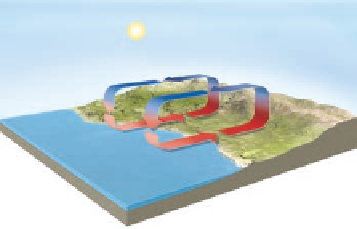Geoscience Reference
In-Depth Information
Climate and the Factors
That Affect It
day-to-day weather in any particular place. In contrast to this
relatively short-term view, climatologists study long-term tem-
perature and precipitation patterns that extend from years to cen-
turies. Their research is important to many disciplines outside the
field of geography, including agriculture, architecture, ecology,
forestry, and economics, because climate is a factor that influ-
ences human behavior and natural processes in a variety of ways.
Before investigating the nature and distribution of world
climates, we should review all the factors that play a role in
the long-term weather patterns for a region (Figure 9.1). Given
what has been covered so far in this topic, these variables should
come as no surprise to you.
When most people think of what “climate” means, they fre-
quently think it is another word for “weather.” This is a common
misconception. The term
weather
refers to the state of the at-
mosphere at a specific place and time on the Earth's surface. For
example, the weather is described when you say something like
“it's cold and rainy today.” Think about it for a moment—what
is
the weather as you are reading this chapter? The concept of
climate
is different from that of daily weather because it refers to
the long-term average values of weather elements, such as tem-
perature and precipitation. These averages are based on a 30-year
period of time.
The concept of climate can be viewed geographically be-
cause Earth exhibits distinct climate patterns. The study of this
geographic distribution and the character of Earth's climates is a
subfield of geography called
climatology
. This subfield is not to
be confused with
meteorology
, which is the study of short-term
atmospheric phenomena such as thunderstorms that constitute
1.
Latitude
—The two latitudinal variables critical to climate
are the intensity of radiation and the length of the day,
which are intimately related to the Earth-Sun geometric
relationship. On average, lower latitudes receive more
insolation over the course of the year than high latitudes
because the Sun shines more directly on these locations.
This insolation variability has a direct impact on ambient
(overall) air temperature.
Figure 9.1 Variables that influence global climates.
The climate of any given place is determined by the interaction of many factors,
such as Earth-Sun relationships, latitude, marine/continental relationships, air circulation, and topography.
Weather
Day-to-day changes that occur in temperature and
precipitation.
Climate
Average precipitation and temperature characteris-
tics for a region that are based on long-term records.


























































